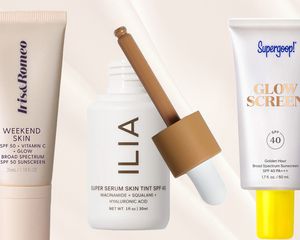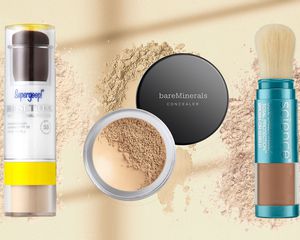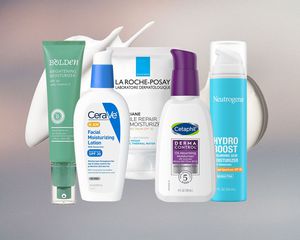:max_bytes(150000):strip_icc()/Stocksy_txpb4b9dc56H9h300_Medium_4067394-f387dea46dba449b856f10dd9bacb09e.jpg)
Stocksy
If you've been growing more environmentally conscious, chances are you've been rethinking your approach to sunscreen. And we're willing to bet you've come across the term "reef-safe sunscreen" as part of your research.
Also referred to as reef-friendly sunscreen, reef-safe sunscreen is SPF formulated without oxybenzone and octinoxate, two popular ingredients in chemical sunscreens that have been shown to cause coral bleaching and harm marine life in the world's oceans. Ahead, discover everything there is to know about environmentally-conscious SPF (including whether or not it's really necessary) straight from board-certified dermatologists Laurel Geraghty, MD, Rachel Nazarian, MD, and Rina Allawh, MD.
Meet the Expert
- Laurel Geraghty, MD, is a board-certified dermatologist with Dermatology & Laser Associates, LLP.
- Rachel Nazarian, MD, is a board-certified dermatologist with Schweiger Dermatology Group in New York City.
- Rina Allawh, MD, is a board-certified dermatologist with Schweiger Dermatology Group in King of Prussia, Pennsylvania.
What Is Reef-Safe Sunscreen?
Reef-safe sunscreen is often used to describe SPF products made without oxybenzone or octinoxate, says Geraghty. (Although there isn't a single formal or scientific definition for the term.)
While there are a handful of other potentially harmful ingredients as they relate to the ocean—and we'll get to them below—Geraghty says that oxybenzone and octinoxate are the main focus due to Hawaii banning the ingredients (which was proposed in 2018 and went into effect on January 1, 2021).
As Geraghty points out, reef-friendly SPF is typically formulated with zinc oxide, "a gentle, safe ingredient that offers broad-spectrum protection from ultraviolet light." Unlike nano-Zinc oxide, zinc oxide isn't likely to harm marine life or human cells and organs, making it a healthier sun protection choice. Another ingredient commonly found in reef-safe sunscreen (typically categorized as mineral sunblock) is titanium dioxide. According to the Environmental Working Group's 2020 Guide to Sunscreens, these two ingredients are the only two UV filters considered truly safe—both for people and the environment—by the FDA.
How Does Sunscreen Impact Coral Reefs?
UV filters—including oxybenzone, octinoxate, nano-titanium dioxide, nano-zinc oxide, and octocrylene, among other ingredients—can negatively impact the world's oceans in several ways.
According to the National Ocean Service, when we swim or even shower, the sunscreen slathered on our skin can end up in the world's waterways. While you might think that at that point, it's so diluted that it couldn't possibly cause a problem, think again: The Ocean Foundation reported that "an estimated 14,000 tons of sunscreen is believed to be deposited in oceans annually with the greatest damage found in popular reef areas such as Hawaii and the Caribbean." Sunscreen chemicals can bleach, deform, and kill coral reefs, impair algae growth and photosynthesis, decrease fertility and reproduction among fish, and cause birth defects among marine life at large.
As grateful as we are for emerging studies on the topic, Geraghty points out that more studies still need to be conducted. "In the laboratory, certain sunscreen ingredients have been shown to contribute to coral reef bleaching—a sign of damage to reefs or an unhealthy reef," she explains. "Other studies that examined the levels of these sunscreen ingredients in the Hawaiian waters showed that the amounts were significantly lower (at least one-thousand-fold lower) than the doses that caused coral damage in the lab." Ultimately, there's still much to learn about sunscreen's effects on coral reefs and marine life in general.
Is Reef-Safe Sunscreen Legitimate?
Nazarian tells us there is very little to back the theory of "reef-safe" sunscreen since the original studies were done years ago. "These studies are the ones that triggered the massive fear and passing of legislation to alter what ingredients were being used," she says, adding that since the original studies were released, subsequent studies have been conducted that now question the findings.
"The ingredients banned for 'reef-safe' reasons have been growing a bad reputation but without science-backing," says Nazarian. "There have been many headlines regarding their impact on the environment, specifically the coral reefs. Coral reef bleaching and damage to the oceanic environment appear to correlate with temperature more often than in areas where tourism and higher levels of sunscreen are found. The studies that were performed showing a negative impact of these sunscreen ingredients, such as oxybenzone/octinoxate, on coral reefs were done using much higher concentrations than they're actually found, and have yet to be reproduced in all subsequent studies."
Another big debate surrounding reef-safe sunscreen is that there isn't one set definition, as the terms "reef-safe" and "reef-friendly" aren't regulated. (At least not yet; who knows what will happen now that Hawaii's ban is in place.) "There is growing concern about the impact that humans may have on the environment, and we need additional studies to understand just how much of an impact our personal care products may have on our coral reefs," says Geraghty.
That being said, there's no harm in using a "reef-safe" sunscreen, so it's certainly an option if it makes you more comfortable.
How Can You Tell if a Sunscreen Is Reef-Safe?
"Simply put, if it's a purely physical or mineral sunscreen, with non-nano zinc and titanium as the only active ingredients, you're likely in the clear," says Nazarian, who advises reading the label to see if the product contains any of the ingredients you want to avoid. Mineral formulas often include the words "reef-safe" or "reef-friendly" on the packaging, but don't always do so, so just look for non-nano zinc or titanium dioxide as the active ingredient.
"It's best to ask your board-certified dermatologist or to do your own evidence-based research using peer-reviewed journals and follow the facts," she continues. "Regardless, some states have banned oxybenzone, octocrylene, and octinoxate, some removing nano-sized ingredients, and called these products 'reef-safe,' which you can discern from labeling suggesting that they're reef-safe."
Sunscreen Ingredients to Avoid to Stay Reef-Safe
Since reef-safe sunscreens aren't regulated, it helps to know which specific ingredients should be avoided (and why). With that in mind, and to help make your sunscreen shopping as simple as possible, below is a comprehensive list of the sunscreen ingredients you should avoid to meet general reef-safe standards.
- Oxybenzone: A popular UV filter rated as a red 8 on the EWG's sunscreen scale, oxybenzone has been connected not only to coral bleaching but to human birth defects, too.
- Octinoxate: Rated a yellow 5 on the EWG’s sunscreen scale, octinoxate has been shown to affect hormones, reproductive systems, and behavioral alterations in animal studies.
- Benzophenone-1 and -8: Benzophenone is a popular UV filter often found in enamels and nail polishes. Its purpose is to protect products from deteriorating—but, in the process, it can deteriorate the skin and the environment.
- PABA: While PABA can absorb UVB radiation, Save the Reef says to avoid it at all costs, as it can affect the reefs.
- 4-Methylbenzylidene Camphor: Also known as Enzacamene, Methylbenzylidene Camphor is a popular UV filter known to cause harm to marine life and coral reefs.
- 3-Benzylidene Camphor: The Hawaiian National Park Service lists this popular UV filter as an ingredient to avoid at all costs.
- Nano-Titanium Dioxide: Since it's a form of approved mineral sunscreen, you might be confused as to why nano-TD makes the list. In short, the smaller the particles, the more they can cause harm to the environment. Hence why this one is left out of reef-friendly sunscreens.
- Nano-Zinc Oxide: Like NTD, NZO is a no-go thanks to its ultra-fine nature. In short, you'll want to avoid nanos.
- Octocrylene: The National Ocean Service says to steer clear of this popular UV filter, which can lead to marine harm.
Byrdie Tip
For the most streamlined sunscreen shopping, head to the EWG’s Guide to Sunscreens, where you can search the SPF you have in mind to uncover how healthy it is for you and the environment. Green is good, yellow is iffy, and red should be avoided if at all possible.
The Final Takeaway
More studies need to be conducted to offer conclusive evidence surrounding reef-safe sunscreen. That said, although she would still advocate that any sunscreen is better than no sunscreen from a skin health perspective, Rina Allawh, MD, says it's important to consider how our actions can impact the world around us. "My recommendation is to opt for a non-nano, mineral-based sunscreen that contains ingredients such as zinc oxide and titanium dioxide," she shares.
Beyond ingredients, Geraghty says choosing the right SPF and knowing when to reapply is essential. "Skin cancer is the most common kind of cancer in our country, and we must protect ourselves from the sun and avoid sunburn to keep skin healthy and to reduce the risk of skin cancer," she says. "No matter our skin type, consistent use of a broad-spectrum, SPF 30+ sunscreen is an important part of keeping our body's largest organ healthy. For sunscreen to work effectively, we need to apply it liberally, rub it in thoroughly, and reapply it every two hours that we're remaining outside—sooner if we've been swimming or sweating since water, heat, light, and sweat break down sunscreens more quickly."



